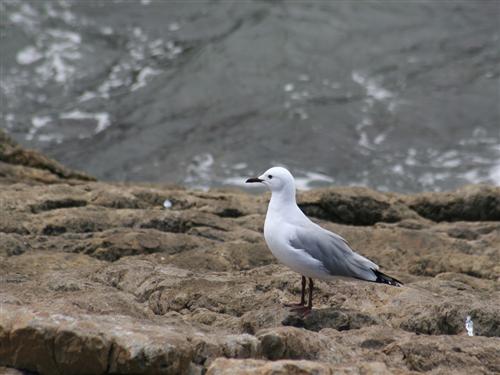The Orange-Senqu basin is home to a wide variety of endemic species (endemism means that a species is not naturally found anywhere else). The nature and distribution of endemic species of the Orange-Senqu River basin are described below, by country.
Botswana
Botswana has more than 900 species of mammals, amphibians, birds and reptiles, and 0,8% of these are endemic to Botswana (Mongabay.com 2009). Some 30,2% of the country is protected, three times the sub-Saharan Africa average of 10,9% (Earth Trends 2009). Botswana has one RAMSAR wetland of international importance: the inland Okavango delta. The Okavango empties into the Kalahari desert to form the largest inland delta in the world.
Table 1: Number of total and endemic species in Botswana.
|
Taxon
|
Total Number of Species in Botswana
|
Total Number of Endemic Species in Botswana
|
|
Plants
|
2151
|
174
|
|
Reptiles
|
133
|
4
|
|
Amphibians
|
28
|
0
|
|
Mammals
|
169
|
0
|
|
Fish*
|
1
|
0
|
|
Breeding Birds
|
184
|
3
|
Source: Adapted from Mongabay.com 2009; *Earth Trends 2009
Lesotho
Though not as prominent as in other African states that have well-established parks and game reserves, Lesotho has a variety of plants and animals (Mokuku et al. 2002). Recent studies (e.g., Mokuku et al. 2002) show that Lesotho has 2 961 documented plant species and at least 132 species of Thallophytes: algae and fungi. The total number of endemic plant species is estimated at 27, plus one endemic subspecies. Lesotho also has a variety of fauna: there are 63 mammal species recorded in the country. Historical records indicate an additional 19 species once existed in Lesotho but these are now locally extinct – and unfortunately two of these are also globally extinct. Tables providing an overview of biodiversity in the four Orange-Senqu River basin states have been compiled and are provided below. The total number of species recorded for Lesotho is shown in the table below.
Table 2: Biological diversity in Lesotho.
|
Group
|
Number of Current Species
|
Number of Historical Species
|
Total
|
|
Mammals
|
63
|
19
|
82
|
|
Birds
|
318
|
22
|
340
|
|
Reptiles
|
40
|
3
|
43
|
|
Amphibians
|
19
|
-
|
19
|
|
Fish
|
14
|
-
|
14
|
|
Invertebrates
|
1 279
|
-
|
1 279
|
|
Plants and Thallophytes
|
3 092
|
-
|
3 092
|
Source: ORASECOM 2007e, Mokuku et al. 2002

Hartlaub Gulls are endemic to the Atlantic coastline of South Africa and Namibia.
Source:MBoy68 2007
( click to enlarge )
Namibia
The majority of Namibia’s endemic species are found along the western edge of the escarpment, in the transition zone between the Desert, Karoo and Savanna biomes. Another hotspot is the Succulent Karoo biome found in southern Namibia; the harsh conditions of the arid environment have forced flora and fauna to adapt, creating an abundance of endemic species.
The Sperrgebiet National Park was established in 2004 and extends up the coast of Namibia from the Orange River Mouth to Oranjemund. Covering 3% of Namibia's land area, the park has been largely innaccesible to the public and scientists over the last 100 years because of its use as a mining area by DeBeers. The area of the park encompasses nearly the entire northern extent of the Succulent Karoo vegetation and with an estimated 776 plant species, including 234 endemic species, the Park arguably has some of the highest biodiversity in the country (SKEP 2009).
Table 3: Number of total and endemic species in Namibia.
|
Taxon
|
Total Number of Species in Namibia
|
Total Number of Endemic Species in Namibia
|
|
Plants
|
4 334
|
687
|
|
Reptiles
|
256
|
71
|
|
Amphibians (all frogs)
|
70
|
6
|
|
Fish
|
114
|
5
|
|
Arachnids
|
5 650
|
89
|
|
Birds
|
644
|
14
|
|
Insects
|
35 000
|
1 541
|
Source: Adapted from the Namibia Nature Foundation 2009
South Africa
South Africa has the third highest level of biological diversity in the world, with 7,5% of the worlds vascular plants, 5,8% of the world’s mammal species, 8% of the world’s bird species, 4,6% of the world’s reptile species, 16% of marine fish species and 5,5% of the world’s recorded insect species (DEAT 2009a).
In South Africa alone, there are 582 protected areas (160 private reserves and 422 areas under national, provincial or local authorities) (DEAT 2009a). The 422 formally protected areas cover some 6% of the land surface area. Although the extent to which viable populations are conserved in such areas is not known, about 74% of plant, 92% of amphibian and reptile, 97% of bird, and 93% of mammal species of South Africa are estimated to be represented (DEAT 2009a). The number and proportion of endemic and threatened species in South Africa are shown in the table below.
Table 4: Number of threatened and endemic species in South Africa.
|
Taxon
|
Total number of species in South Africa
|
% which are threatened
|
% of which are endemic
|
|
Mammals
|
247
|
10,12
|
10,93
|
|
Birds
|
790
|
2,03
|
0,89
|
|
Reptiles
|
299
|
12,04
|
27,09
|
|
Amphibians
|
95
|
16,84
|
37,89
|
|
Freshwater Fish
|
94
|
36,17
|
-
|
|
Invertebrates
|
23 000
|
4,14
|
-
|
Source: WCMC (1994), DEAT (2009a)
